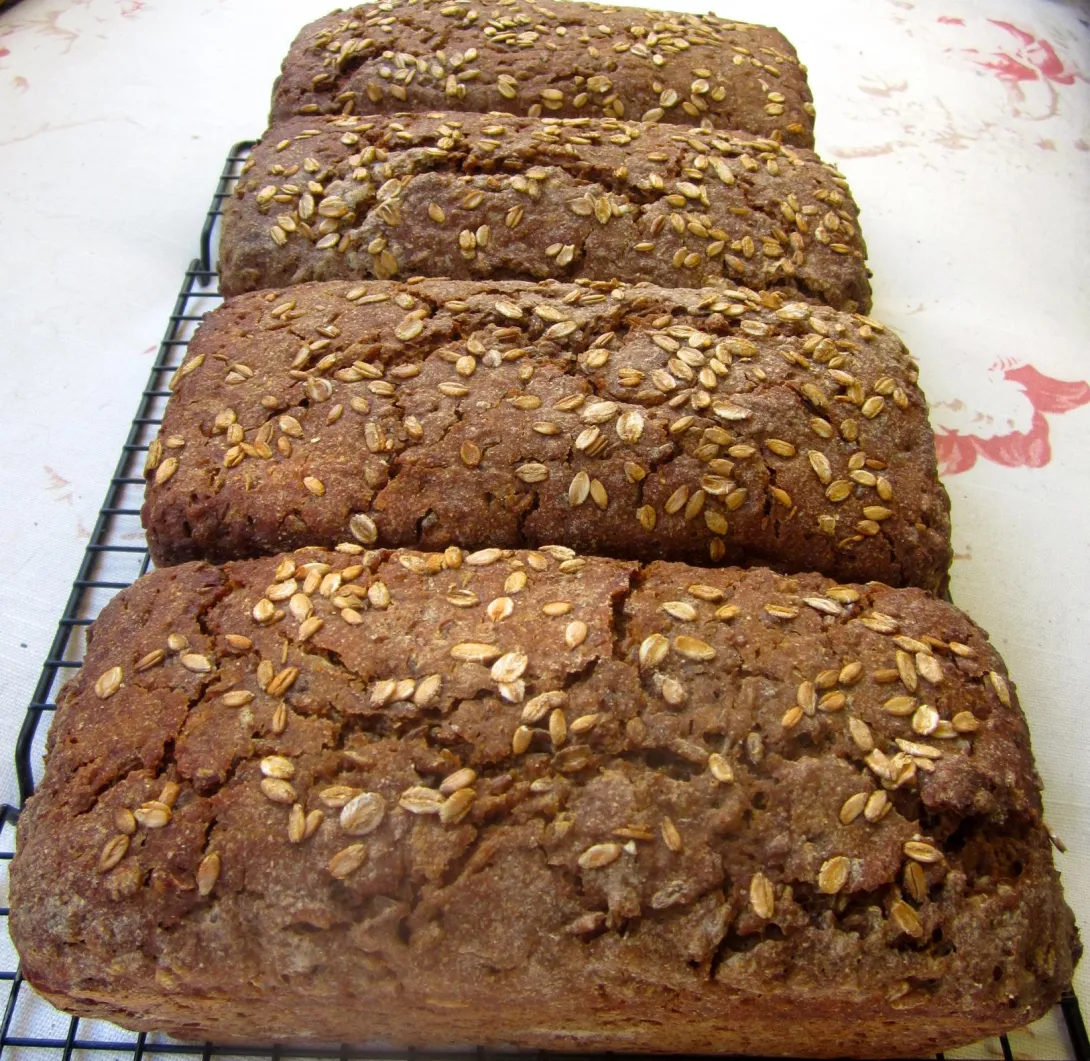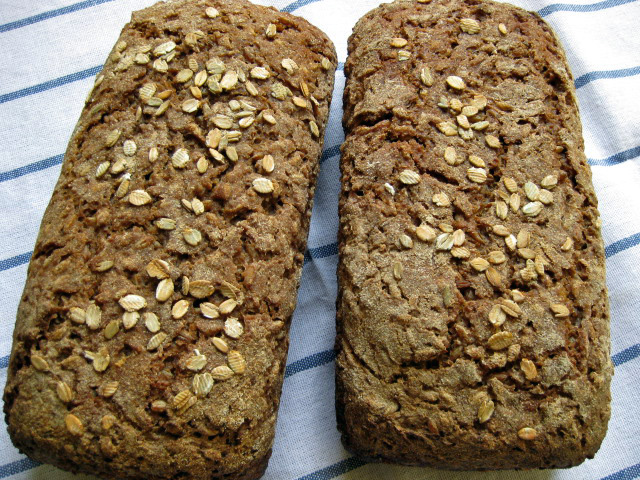
RYE BERRIES
150 g rye berries
water, for soaking
SOAKER
150 g rye flour
5 g salt
113 g water
STARTER
40 g whole wheat mother starter
116 g whole wheat flour
83 g water, lukewarm
FINAL DOUGH
all cooked rye berries
all soaker and starter
37 g whole wheat flour
3 g instant yeast
11 g salt
15 g molasses
3 g honey
1 tsp. rolled rye, for topping

DAY 1 AFTERNOON
In a bowl, cover rye berries with at least 1 inch cold water and let soak for 24 hrs.
DAY 2 EVENING
Drain soaked rye berries, discard water, bring to a boil well covered with fresh water, and let simmer for 30 min. at low temperature. Drain, cover and let cool to room temperature overnight (they can be kept at room temperature for 24 hrs.)
Stir together all soaker ingredients until all flour is fully hydrated. Cover with plastic wrap and leave at room temperature for at least 12 hrs.
Combine all starter ingredients in a bowl to form a ball of dough, then knead (using stand mixer or wet hands) for 2 min. to be sure all ingredients are evenly distributed. Let rest for 5 min., then knead again for 1 min. Cover with plastic wrap and leave at room temperature overnight.
DAY 3 BAKING DAY
If mixing by hand, chop soaker and starter into 12 smaller pieces and sprinkle them with some extra flour to keep pieces from sticking back together (with a good stand mixer this step is not necessary).
If mixing by hand, combine all final dough ingredients in a bowl and knead with wet hands for 2 min. (or use a stand mixer with paddle attachment at low speed). Dough should be soft and slightly sticky.
If kneading by hand: dust work surface with flour, then roll dough in it to coat. Knead for 3-4 min., trying to incorporate only as much flour as needed. (If using a stand mixer, mix with paddle attachment at medium-low speed for 4 min.) Dough should still be slightly sticky.
Let dough rest for 5 min., then resume kneading (hands or mixer) for 1 min. The dough should be still very tacky, verging on sticky. Form dough into a ball and place in lightly oiled bowl, rolling it to coat with oil. Cover with plastic wrap and let rise at room temperature for ca. 45 min, or until it swells and just begins to show signs of growth. (Dough can be refrigerated overnight, remove at least 2 hrs. before using).
Preheat oven to 450 F. Spray loaf pan (8 1/2" by 4") with oil.
Form dough into sandwich loaf and place into pan, sprinkle with rolled rye and spray with oil. Cover pan with aluminum foil, don't let it rise anymore!
Place bread in oven (middle), reduce temperature to 425 F and bake for 35 minutes, until it holds its shape when removed from pan. Take out of the oven, remove aluminum foil, and turn half baked bread out onto a sheet pan (use plastic spatula to loosen it along the edges, if necessary).
Return it to the oven to bake for another about 30 minutes (it should register at least 200 F in the center).
Transfer bread to cooling rack, spray with water and allow to cool. For the first 24 hours keep it in a paper bag to allow it to continue drying out and developing flavor. After that, it can be wrapped in aluminum foil. (Don't keep it in the refrigerator).
Updated with some changes 7/9/15
I've been itching to bake some of this, I'm taking this as a good omen. As soon as the rye berries I ordered arrive I'm all over it. I just hope it turns out half as good as yours!
Beautiful loaves! Did you double the recipe?
When I figure it out... it comes to 3.6% total salt to flour. Which is a bit salty. I'm wondering if the directions didn't say to use 5g of the 12g (adding 7g later) than a total of 17g. Using total grain and flour (473g) 2% is 9.46g salt.
What is your room temperature?
Can I just bake it on the open rack instead and not rotate it?
Mini
Hi, Mini,
Yes, for 2 breads you would just double the recipe.
I adapted a recipe from one of my old German bread baking books to Peter Reinhart's technique, basically first just taking the amounts of ingredients, and then experimenting quite a bit with temperatures, baking times and the right sweetness, until I finally had a product that satisfied me.
I did not change the percentage of salt from the old recipe, the bread doesn't taste overly salty, so I didn't even think of it, but there is no reason why you shouldn't be able to reduce it.
Since I'm baking in my home kitchen, it's always the prevailing temperature, which definitely in Maine is not at all constant, and in winter we turn the heat down to 60 F overnight.
This bread is very moist, the idea of rotating it sidewise I took from P. R.'s recipe for baking the (similiar) German Vollkornbrot, because I found it worked very well ( though with different temperatures and times). But you are welcome to experiment to see how it would turn out on a rack without the rotating.
Another tip: since I'm baking this bread professionally for our local natural food store, I try to cut down on preparation time on the baking day - I don't want to mix the all the final doughs in morning.
Therefore I prepare soaker and starter on the 2. day morning, cook the berries in the afternoon, and make the final dough in the evening, divide it into portions, put those in square 1 quart plastic containers (which stack nicely and also "pre-shape" the dough) and refrigerate them overnight.
When I take them out in the morning they are done rising and only have to come to room temperature (ca. 2 hrs.) before being shaped and baked.
I have a question why spray water on the loaves while cooling? Can I bake the bread in a pullman pan with the lid on?
siuflower
When I experimented with the recipe I tried just covering all the loaves together with a sheet pan, which seemed easier than individually covering them with aluminum foil. Unfortunately I found that the tops were burned. The breads rise a bit, though not much and probably the metal provided too much heat. Maybe this would not happen in a pullman pan - you would have to try it out.
The spraying with water right after baking I found in many German recipes for this kind of dark, dense rye bread. I do not know, whether it's just an old habit or voodoo, but the crust comes out really beautiful, crisp, but not too thick.
These rye breads need much longer time to cool down and develop their flavor (about 24 hrs.). My uneducated theory is that spraying them with water prevents the crust to harden too fast, but I might be totally wrong.
This recipe worked out very nicely! I didn't have rolled rye so I used oats, and I did use a sheet pan to cover them in the oven. It all went really well. It helped that most of my experience is with Peter Reinhart's Whole Grain Breads, so this was a very comfortable recipe for me.
Here are the results (note: the crumb looks almost fluffy in this pic because I was impatient and cut into it a little early - there was some sticking and tearing - tasty though!):
I'm very happy to see how nice your Schwarzbrot turned out! And, yes, we also have the first slices when the bread is still warm, in all its crumbly glory. Of course it develops its full flavor over the course of the next 24 hours, and then doesn't crumble anymore, but who cares - bread warm from the oven is something special.
I will soon post another Schwarzbrot recipe from the North Sea region (Friesisches Schwarzbrot) with a lot of grains which I also like very much.
I'm looking forward to the next one, thanks!
is it similar to the Dutch version here? (third picture).
Gruss,
Jw.
That bread looks nice, but mine is definitely different. There are lots of recipes for Schwarzbrot out there, sometimes the names are just made up to discern one from the other. I got mine some years ago from the internet and tweaked it until the result was really good. It is a dark multigrain sourdough with no commercial yeast added.
I'll post it, then you can see for yourself - and maybe try it.